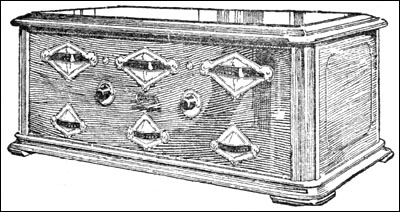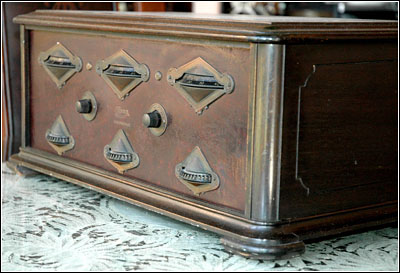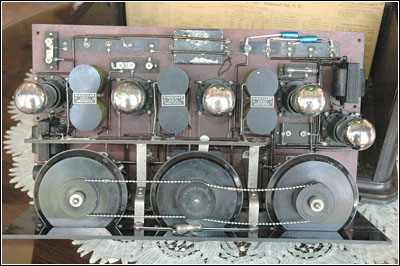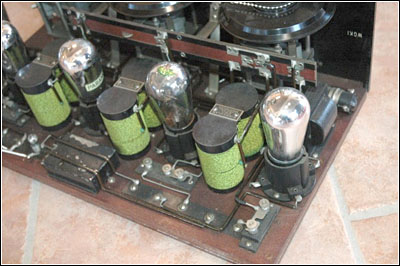Of Old Radios And Related Items--Published Monthly
The Grebe MU-1 "Synchrophase"
BY RICHARD MAJESTIC
Web Edition
Grebe is an important name in radio history. Richard Majestic gives us both a personal story with the MU-1 Synchrophase and a brief company history. (Editor)
The Grebe MU-1 Synchrophase is arguably the best performing TRF battery set made in the 1920s. My MU-1, shown in Figure 1, was purchased in 1924-1925 by my dad. He used batteries, of course, but did not have the matching BC-1 battery case which would have been positioned as a base under the set. He used a horn speaker that was either a Grigsby-Grunow or an Atwater Kent, but it had disappeared before I could salvage it from the family home attic.
As a youngster, I remember the many times my dad tried to make his Grebe radio work, only to give up after hours of fussing with it. Fortunately, as a kid I didn't try to fix it (screw it up). I only took the bead chain off for some nefarious reason. After my mom and dad had died, I helped my sister clean out our childhood house, and I took the Grebe home. That was about 1990, and it got moved from Annapolis, Maryland, to Santa Cruz, California. It still didn't work, since I hadn't looked into repairing it. Interior views of the radio are shown in Figures 2 and 3.
Advertising image of the Grebe Synchrophase.Repairing the Grebe Model MU-1
In 1997, I designed a power supply, bought the parts, along with a set of five N.O.S. Type 201A tubes. I built the power supply into an old Sterling battery eliminator case. I connected up my RCA 100-A speaker and powered up the MU-1. Nothing -- even with 201As glowing like 20-watt light bulbs. So, I connected up my old General Radio 1001A RF signal generator and fed a modulated RF signal into the last RF stage. I could hear a weak audio signal.
I took a good look at the wiring, drew a schematic for the radio, and then tested the audio circuits with an audio generator. The audio section worked just fine. In looking at my schematic, I concluded that possibly the bypass capacitor was the problem. I replaced the capacitor and could then hear the RF generator signal loud and clear -- even though it was not directly connected to any of the set stages.
Figure 1. The Majestic family Grebe Model MU-1 Synchrophase radio.
Figure 2. This bird's-eye view of the MU-1 shows the binocular RF coils, tubes, and tuning drive mechanism.I shut the generator off, connected a 20-foot piece of wire to the antenna terminals of the Grebe and heard radio station KSCO, 1080 kHz loudly. In tuning around, I could hear all the local Santa Cruz, California, AM stations and most of the San Francisco stations too. The old Grebe works quite well.
The Grebe Company and the Model MU-1
Production of the MU-1 continued from late 1924 to early 1927, ultimately reaching over 150,000 radios. During its production lifetime, many improvements were made to the MU-1, the most noteworthy being the bandswitch's allowing further spread of the tuning. The bandswitch is actuated by the center dial at either end of its rotation. The MU-1 tunes over a range of 550 meters to 150 meters.
Chain-drive to the outer dials, driven from the center dial, was added early in production as an attempt at single-dial tuning. Also, audio transformers and tube sockets were improved, and the audio output tube was changed to a Type UX-112A during production. The dial escutcheons were usually finished in lacquered gold, but some later MU-1s had gold-plated escutcheons. The MU-2 is a dry-cell version and uses Type 199 tubes.
When this radio was introduced in 1922, it was revolutionary. It could be tuned with a single tuning control, and Grebe did a good job of making the three tuned stages track the 550 to 150 meter band. However, it was possible to tweak the tuning of each RF stage by turning one of the knobs to the left and right of the center tuning control.
The MU-1 is very sensitive and will separate signals quite well due to its binocular coils and SLF (straight line frequency) condensers which distribute the wave bands so that all stations have equal spacing on the dial. It was also revolutionary in 1922 to have such great selectivity and sensitivity.
Figure 3. A close-up view shows the binocular RF coils, tubes and other components in detail.What a kick! What a great 1920s radio!
References:
Grebe advertising brochure and instruction manual for the Synchrophase.
Richard A. Majestic has more than 30 years experience in broadcast television and radio engineering design and management for such companies as Voice of America and Sony Electronics. He holds ten patents for electronic designs and instrumentation. Now retired, he is the president of the New Mexico Radio Collectors Club. He can be reached at rmajestic@msn.com.
|
[Free Sample] [Books, etc., For Sale] [Subscribe to A.R.C./Renew] [Classified Ads] [Auction Prices] [Event Calendar] [Links] [Home] [Issue Archives] [Book Reviews] [Subscription Information] [A.R.C. FAQ]URL = http://www.antiqueradio.com/Aug08_Majestic_Synchrophase.html Copyright © 1996-2008 by John V. Terrey - For personal use only. Last revised: July 31, 2008. For Customer Assistance please contact ARC@antiqueradio.com or call (866) 371-0512 toll free Pages designed/maintained by Wayward Fluffy Publications Antique Radio Classified |



